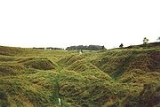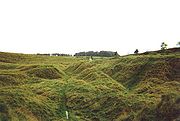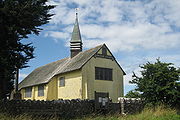
Charterhouse, Somerset
Encyclopedia
Charterhouse, also known as Charterhouse-on-Mendip, is a hamlet
in the Mendip Hills
Area of Outstanding Natural Beauty
(AONB) in the English
county of Somerset
. The area between Charterhouse and Cheddar Gorge including Velvet Bottom and Ubley Warren is covered by the Cheddar Complex
Site of Special Scientific Interest
.
order of Chartreuse
in France
, which was established in Witham
(near Frome
) in 1181 and formed a cell at Charterhouse in 1283 with a grant to mine lead ore.
 There is evidence, in the form of burials in local caves, of human occupation since the late Neolithic
There is evidence, in the form of burials in local caves, of human occupation since the late Neolithic
/Early Bronze Age
.
The lead
and silver
mines
at Charterhouse, were first operated on a large scale by the Romans
, from at least AD 49. At first the lead/silver industries were tightly controlled by the Roman military
, but within a short time the extraction of these metals was contracted out to civilian companies, probably because the silver content of the local ore
was not particularly high. There was also some kind of 'fortlet'
here in the 1st century, and an amphitheatre
. The Roman landscape has been designated as a Scheduled Ancient Monument
.
The parish was part of the Winterstoke Hundred.
After the dissolution of the monasteries
, it was granted to Robert May who constructed a substantial house here and one of his descendants John May became High Sheriff of Somerset
in 1602.
There is further evidence of mine workings in the medieval and Victorian
periods, some of which survives within the Blackmoor Nature Reserve owned by Somerset County Council
. There is also evidence of a rectangular medieval enclosure.
in the limestone
around the village including Manor Farm Swallet
and Upper Flood Swallet
.
 The Church of England parish church
The Church of England parish church
of St Hugh
was built in 1908 by W.D. Caroe
, on the initiative of the Rev. Menzies Lambrick, from the former welfare hall for the lead miners. It is a Grade II* listed building. A cross in the churchyard and the churchyard wall are also listed buildings.
The roof-truss, screen, rood
, and altar
are all made of carved whitened oak
.
Hamlet (place)
A hamlet is usually a rural settlement which is too small to be considered a village, though sometimes the word is used for a different sort of community. Historically, when a hamlet became large enough to justify building a church, it was then classified as a village...
in the Mendip Hills
Mendip Hills
The Mendip Hills is a range of limestone hills to the south of Bristol and Bath in Somerset, England. Running east to west between Weston-super-Mare and Frome, the hills overlook the Somerset Levels to the south and the Avon Valley to the north...
Area of Outstanding Natural Beauty
Area of Outstanding Natural Beauty
An Area of Outstanding Natural Beauty is an area of countryside considered to have significant landscape value in England, Wales or Northern Ireland, that has been specially designated by the Countryside Agency on behalf of the United Kingdom government; the Countryside Council for Wales on...
(AONB) in the English
England
England is a country that is part of the United Kingdom. It shares land borders with Scotland to the north and Wales to the west; the Irish Sea is to the north west, the Celtic Sea to the south west, with the North Sea to the east and the English Channel to the south separating it from continental...
county of Somerset
Somerset
The ceremonial and non-metropolitan county of Somerset in South West England borders Bristol and Gloucestershire to the north, Wiltshire to the east, Dorset to the south-east, and Devon to the south-west. It is partly bounded to the north and west by the Bristol Channel and the estuary of the...
. The area between Charterhouse and Cheddar Gorge including Velvet Bottom and Ubley Warren is covered by the Cheddar Complex
Cheddar Complex
The Cheddar Complex is a 441.3 hectare biological Site of Special Scientific Interest near Cheddar around the Cheddar Gorge and north east to Charterhouse in the Mendip Hills, Somerset, notified in 1952....
Site of Special Scientific Interest
Site of Special Scientific Interest
A Site of Special Scientific Interest is a conservation designation denoting a protected area in the United Kingdom. SSSIs are the basic building block of site-based nature conservation legislation and most other legal nature/geological conservation designations in Great Britain are based upon...
.
Name
The name is believed to come from the CarthusianCarthusian
The Carthusian Order, also called the Order of St. Bruno, is a Roman Catholic religious order of enclosed monastics. The order was founded by Saint Bruno of Cologne in 1084 and includes both monks and nuns...
order of Chartreuse
Grande Chartreuse
Grande Chartreuse is the head monastery of the Carthusian order. It is located in the Chartreuse Mountains, north of the city of Grenoble, in the commune of Saint-Pierre-de-Chartreuse , France. Originally, the château belonged to the See of Grenoble...
in France
France
The French Republic , The French Republic , The French Republic , (commonly known as France , is a unitary semi-presidential republic in Western Europe with several overseas territories and islands located on other continents and in the Indian, Pacific, and Atlantic oceans. Metropolitan France...
, which was established in Witham
Witham Friary
Witham Friary is a small village and civil parish located between the Somerset towns of Frome and Bruton. It is in the Cranborne Chase and West Wiltshire Downs Area of Outstanding Natural Beauty and the ancient Forest of Selwood.- History :...
(near Frome
Frome
Frome is a town and civil parish in northeast Somerset, England. Located at the eastern end of the Mendip Hills, the town is built on uneven high ground, and centres around the River Frome. The town is approximately south of Bath, east of the county town, Taunton and west of London. In the 2001...
) in 1181 and formed a cell at Charterhouse in 1283 with a grant to mine lead ore.
History

Neolithic
The Neolithic Age, Era, or Period, or New Stone Age, was a period in the development of human technology, beginning about 9500 BC in some parts of the Middle East, and later in other parts of the world. It is traditionally considered as the last part of the Stone Age...
/Early Bronze Age
Bronze Age
The Bronze Age is a period characterized by the use of copper and its alloy bronze as the chief hard materials in the manufacture of some implements and weapons. Chronologically, it stands between the Stone Age and Iron Age...
.
The lead
Lead
Lead is a main-group element in the carbon group with the symbol Pb and atomic number 82. Lead is a soft, malleable poor metal. It is also counted as one of the heavy metals. Metallic lead has a bluish-white color after being freshly cut, but it soon tarnishes to a dull grayish color when exposed...
and silver
Silver
Silver is a metallic chemical element with the chemical symbol Ag and atomic number 47. A soft, white, lustrous transition metal, it has the highest electrical conductivity of any element and the highest thermal conductivity of any metal...
mines
Mining
Mining is the extraction of valuable minerals or other geological materials from the earth, from an ore body, vein or seam. The term also includes the removal of soil. Materials recovered by mining include base metals, precious metals, iron, uranium, coal, diamonds, limestone, oil shale, rock...
at Charterhouse, were first operated on a large scale by the Romans
Roman Empire
The Roman Empire was the post-Republican period of the ancient Roman civilization, characterised by an autocratic form of government and large territorial holdings in Europe and around the Mediterranean....
, from at least AD 49. At first the lead/silver industries were tightly controlled by the Roman military
Roman legion
A Roman legion normally indicates the basic ancient Roman army unit recruited specifically from Roman citizens. The organization of legions varied greatly over time but they were typically composed of perhaps 5,000 soldiers, divided into maniples and later into "cohorts"...
, but within a short time the extraction of these metals was contracted out to civilian companies, probably because the silver content of the local ore
Ore
An ore is a type of rock that contains minerals with important elements including metals. The ores are extracted through mining; these are then refined to extract the valuable element....
was not particularly high. There was also some kind of 'fortlet'
Castra
The Latin word castra, with its singular castrum, was used by the ancient Romans to mean buildings or plots of land reserved to or constructed for use as a military defensive position. The word appears in both Oscan and Umbrian as well as in Latin. It may have descended from Indo-European to Italic...
here in the 1st century, and an amphitheatre
Amphitheatre
An amphitheatre is an open-air venue used for entertainment and performances.There are two similar, but distinct, types of structure for which the word "amphitheatre" is used: Ancient Roman amphitheatres were large central performance spaces surrounded by ascending seating, and were commonly used...
. The Roman landscape has been designated as a Scheduled Ancient Monument
Scheduled Ancient Monument
In the United Kingdom, a scheduled monument is a 'nationally important' archaeological site or historic building, given protection against unauthorized change. The various pieces of legislation used for legally protecting heritage assets from damage and destruction are grouped under the term...
.
The parish was part of the Winterstoke Hundred.
After the dissolution of the monasteries
Dissolution of the Monasteries
The Dissolution of the Monasteries, sometimes referred to as the Suppression of the Monasteries, was the set of administrative and legal processes between 1536 and 1541 by which Henry VIII disbanded monasteries, priories, convents and friaries in England, Wales and Ireland; appropriated their...
, it was granted to Robert May who constructed a substantial house here and one of his descendants John May became High Sheriff of Somerset
High Sheriff of Somerset
The Office of High Sheriff of Somerset is an ancient High Sheriff title which has been in existence for over one thousand years. The position was once a powerful position responsible for collecting taxes and enforcing law and order in Somerset a county in South West England. In modern times the...
in 1602.
There is further evidence of mine workings in the medieval and Victorian
Victorian era
The Victorian era of British history was the period of Queen Victoria's reign from 20 June 1837 until her death on 22 January 1901. It was a long period of peace, prosperity, refined sensibilities and national self-confidence...
periods, some of which survives within the Blackmoor Nature Reserve owned by Somerset County Council
Somerset County Council
Somerset County Council is the county council of Somerset in the South West of England, an elected local government authority responsible for the most significant local government services in most of the county.-Area covered:...
. There is also evidence of a rectangular medieval enclosure.
AONB Centre
The outdoor activity centre and headquarters of the Mendip Hills AONB is based at Charterhouse, with accommodation, classrooms and offices.Caves
There are several Caves of the Mendip HillsCaves of the Mendip Hills
The Caves of the Mendip Hills are formed by the particular geology of the Mendip Hills, with large areas of limestone worn away by water makes it a national centre for caving. The hills conceal the largest underground river system in Britain.- Geology :...
in the limestone
Limestone
Limestone is a sedimentary rock composed largely of the minerals calcite and aragonite, which are different crystal forms of calcium carbonate . Many limestones are composed from skeletal fragments of marine organisms such as coral or foraminifera....
around the village including Manor Farm Swallet
Manor Farm Swallet
Manor Farm Swallet is a cave in the limestone of the Mendip Hills, in Somerset, England which was subject to numerous failed digging attempts between 1947 and 1973 as the surface shafts kept collapsing....
and Upper Flood Swallet
Upper Flood Swallet
Upper Flood Swallet which was originally known as Blackmoor Flood Swallet, is a cave near Charterhouse, in the carboniferous limestone of the Mendip Hills, in Somerset, England. The cave is part of the Cheddar Complex SSSI....
.
Church

Church of England parish church
A parish church in the Church of England is the church which acts as the religious centre for the people within the smallest and most basic Church of England administrative region, known as a parish.-Parishes in England:...
of St Hugh
Hugh of Lincoln
Hugh of Lincoln was at the time of the Reformation the best-known English saint after Thomas Becket.-Life:...
was built in 1908 by W.D. Caroe
W.D. Caroe
William Douglas Caroe was a British architect, particularly of churches. His sons were the architect A.D.R. Caroe, and Sir Olaf Caroe...
, on the initiative of the Rev. Menzies Lambrick, from the former welfare hall for the lead miners. It is a Grade II* listed building. A cross in the churchyard and the churchyard wall are also listed buildings.
The roof-truss, screen, rood
Rood
A rood is a cross or crucifix, especially a large one in a church; a large sculpture or sometimes painting of the crucifixion of Jesus.Rood is an archaic word for pole, from Old English rōd "pole", specifically "cross", from Proto-Germanic *rodo, cognate to Old Saxon rōda, Old High German ruoda...
, and altar
Altar
An altar is any structure upon which offerings such as sacrifices are made for religious purposes. Altars are usually found at shrines, and they can be located in temples, churches and other places of worship...
are all made of carved whitened oak
Oak
An oak is a tree or shrub in the genus Quercus , of which about 600 species exist. "Oak" may also appear in the names of species in related genera, notably Lithocarpus...
.

